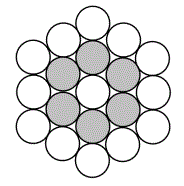| Problem |
Solution |
3) In May of 2000, I was eleven times as old as my son, Taylor. Nine years later I was six more than
three times his age. How old was Taylor in May 2000? |
Use M for Mom's age in 2000.
Use T for Taylor's age in 2000.
1. Write the equation for Mom's age in 2000: M = 11T
2. Write the equation for Mom's age 9 years later:
(M+9) = 3(T+9) + 6
so, putting 11T in for M:
(11T + 9) = 3T + 27 + 6
8T = 33 - 9
8T = 24, so T = 3 years old
|
|
4) Rosie has a prime location for a lemonade stand in front of her house and she rents it out when
she isn't using it for $5 an hour. Chadd decides to try it. He borrows $10 worth of supplies from
his mom that he'll have to pay back, and decides to charge $1 per cup. What should his average
selling rate of cups per hour be if he wants to make a profit of $30 in 4 hours? |
1. Compute Chadd's profit/hour = 30/4 = $7.50/hour.
2. Compute Chadd's total cost for 4 hours =
(fixed cost + rent) = $10 + 4 X $5 = $30.
3. Compute Chadd's total expected income if he is to make this profit (cost + profit) =
30 + 30 = $60.
4. Divide this by 4 to get the hourly cup rate = 60/4 =
15 cups/hour.
|
5) In the pattern of circles shown, each new encircling layer adds
more circles. The layers alternate in color beginning with white,
then grey, and then white. How many circles will be in the next
white layer?

|
The figure has 6 sides and with each layer still has 6 sides.
1. Each layer adds 1 to the length of a side, so the next gray layer has sides that are 4 circles long and the next white layer has sides that are 5 circles long.
2. But the circles on the corners are shared by the adjacent sides, so 6 of them must be subtracted.
3. Doing this, the next gray layer has 6 X 4 = 24 circles on each side - 6 shared circles, leaving 18 circles in the gray layer.
4. The next white layer has 5 circles on each side
- 6 shared circles, leaving 6 X 5 - 6 =
24 circles in the next white layer.
|